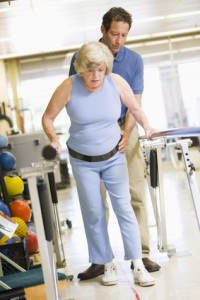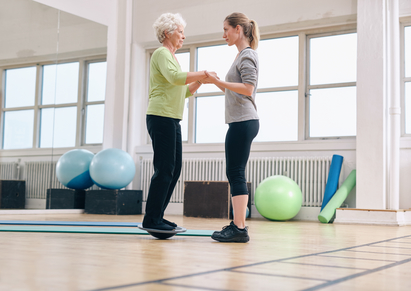Five Tips for Training Clients with Parkinson’s and/or Multiple Sclerosis
When training clients with a neuromuscular disease such as Parkinson’s and/or Multiple Sclerosis there are many challenges. The challenges can range from physical to emotional setbacks. It is important to focus on the physical as well as mental capacity. There are certain patterns associated with exercises that provide balance, core, flexibility, facial, and hand motor training, that keep the mind focused. Below are five tips when working with clients who have Parkinson’s and/or Multiple Sclerosis.
 Balance Training
Balance Training
Balance is one of the first things to decrease as we get older, but much quicker with those with Parkinson’s and/or Multiple Sclerosis. One common injury is falling so it is important to focus on balance. Start with simple single exercises to work on balance. Even standing with just the eyes closed can provide a challenge. Also try unstable surfaces like a balance board or Airex-pad to challenge balance.
Core Training
Incorporating core exercises will help your clients with the balancing and movement exercises. If the client can stabilize core muscles during the balance exercises it will help them to be more aware of posture and overall strength. Plank exercises are great for utilizing the core. Also a seated ball lift one leg while maintaining posture helps with posture when sitting.
Flexibility Training
Flexibility or range of Motion exercises combine Balance and Core Training to help improve flexibility and coordination. There are two types of flexibility training, Static and Dynamic. Static stretching is holding a specific stretch for 45-60 seconds. This is great after working out to prevent injury and improve range of motion. Dynamic flexibility is more movement based. Exercises such as reverse lunges help improve flexibility while moving, while challenging balance and the core.
Facial Exercises
Particularly with Parkinson’s clients, they will get a look to their face that looks like there is no expression. To keep these muscles in the face active doing simple jaw, mouth, eyebrow, and cheek movements will help keep facial muscle active.
Writing
Writing is important keep the mind and emotional part of having Parkinson’s and/or Multiple Sclerosis active. Motor skills in the hand will decrease as well as focus and concentration. So things like cross word puzzles and word finds are great for incorporation of mind and body.
In summary, it is critical to use all of these tips for Parkinson’s and Multiple Sclerosis training in progression. Each client is different, so challenge them to their fitness level. Progress or digress exercises accordingly. Take into account the psychological well-being of your client when progressing them in their workout regimen.
Jason Williams has been a personal trainer, pilates instructor, and wellness coach for 13 years and is a graduate from Lynchburg College in Virginia with a Bachelor of Science degree in Sports Medicine. While at Lynchburg College he was a 1st team All-Conference Track and Field Athlete. Jason has worked with a wide variety of clientele from kids, professional athletes, seniors and special populations. He recently wrote a children’s health and fitness book, The Adventures of Frankie Fitness, which motivates kids and adults to live a healthy lifestyle. He currently works at The Maryland Athletic Club in Baltimore, Maryland. Find Jason at Charm City PT.

